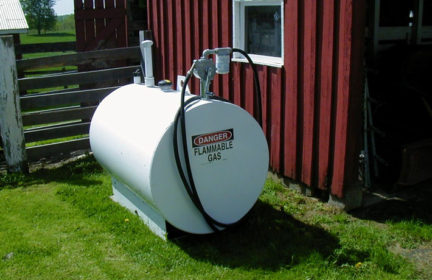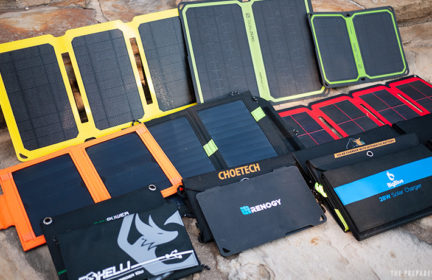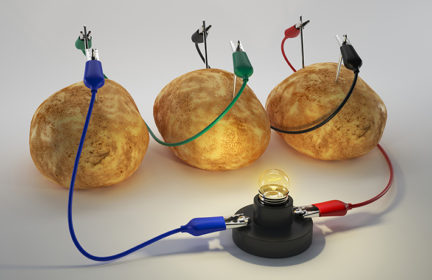Going solar with my home (maybe): a diary
I’ve been wanting to do solar since we first moved into our house in 2015. We’re on 17 acres, and we’re 100% electric — everything from the range to heating and cooling to the well pump is on the grid. So we’re actually more “on-grid” than were in Austin, because if the power’s out then we can’t heat the house and the taps don’t work.
Because I’m a prepper, and because we do have substantial blackouts here periodically due to electrical storms, I’d like to back up the some or part of the property with solar + battery backup.
So as I think through this process and my options, I figured I’d make a thread in there to get insight from others, and to share my experiences. I want to learn as much as I can, so that I not only do this right for myself and my family, but so that I can work on a guide on this topic for The Prepared. In fact, my main goal is to come out the other end of this process with — at a minimum — enough info to do some kind of guide, even if I don’t end up actually pulling the trigger on the actual solar install right now.
I do want to acknowledge up-front that my living and financial situation is not very typical (I’ve successfully sold a company, and live on a ranchette with some horses and a pond and so on). I say this because I’m just going to be kinda honest about numbers and specifics in this thread, and I know that so many people are struggling… I don’t want to come off like I think all my particular parameters are generally applicable; they definitely are not. But there is a lot of cost/benefit calculation involved in sizing a solar install, and thinking through all that in any kind of worthwhile way requires putting some actual numbers down.
Here are a few parameters and considerations I’m working with:
Location: I’m in Central TX right north of Austin (Georgetown area), so lots of sun.
Property: We have a large house with a metal roof that has terrible, ancient insulation. It would cost us $30-$40K to get the roof redone with modern closed-cell insulation. That would significantly cut our bill, from what I’m told (though I don’t know how much), so that is something I’m seriously considering.
We have a well on a separate meter that runs about $40/month, and are adding a 1200sqft guest house that may be occupied much of the year.
We can easily do a ground-mounted setup, since we’re on 17 acres. We can also do it next to the meter and keep the trenching at under 50 ft.
Current electrical usage: We’re paying $0.09 kwh, which is pretty cheap. But given the state of the roof and size of the house, we’re doing over 5,100 kwh per month on average, which is nuts. Our bill is around $425/mo average, though it’s way way worse than that in the summers (gets close to $600). When we add the guest house in we’re looking at around 5,600 kwh per month roughly.
Timing: Sunpower and other companies are going to be launching Powerwall competitors in early 2021, so theoretically (barring battery supply chain problems, war with China, and a billion other things that could go wrong between now and then), batteries should be a lot cheaper in about Q3 of next year. So if I did the solar now and the batteries later, I could get a lot more bang per buck. But of course then I’d have no backup, and if I lose grid power my solar won’t help. So solar-only is not that appealing to me.
Financial stuff: I’ve started talking to Freedom Solar — they’re a SunPower dealer. They’ll finance up to $100K at 2.9%, no money down, 25-year terms. If you go over $100K, you have to pay the delta up-front to get below that threshold.
They quoted me like $140K for an 88-panel Sunpower system to replace 79% of my usage, backed up with two Powerwall batteries. This kinda feels like a lot! Especially since I’d need to pay them $40K up-front to get the financing down to $100K.
This is a 25-year loan, so the monthly note works out to over $420/month. If I factor in another $90/month in ongoing electric utility payments (remember I’d only be at 79% replacement) then that’s ~$500/month for about 25 years for electricity.
I could tell the salesperson was used to talking to people who just wanted to do solar for reasons of replacing their existing electrical bill with a payment on a solar system that will give them some inflation protection and increase their home value. But as a prepper I’m more interested in the backup aspect than I am in the inflation protection and home value aspects.
Options: I do have the capability to put the $40K down to do this. But obviously that’s a big chunk, and I could do a lot of other things with $40K, including buy gold or bitcoin or stocks, or fix my roof (more on that in a minute, tho).
As pessimistic as I am about the upcoming fall and winter, if I’m thinking about allocating $40K of my portfolio as a hedge against economic catastrophe risk, then $40K in a personal off-grid setup looks better than $40K in many other asset classes.
Anyway, here are some options I’m thinking about:
- I could put $40K down for the full $140K package of 88 panels + two Powerwalls. I don’t know that I love this, because if I do end up with a new roof in a few years, and kwh usage drops by like 30%, then I’m way over-provisioned and am still paying ~$450/month for electricity and not seeing real savings from the roof.
- I could spend $40K to redo my roof, and then buy a smaller solar system. Not sure how much money I’ll be saving via the new roof until I actually do it, though.
- I could start with just $100K worth of solar and wait for batteries to get cheaper next year, and put $40K somewhere else. But as I said, doing this without the batteries doesn’t scratch the prepper itch.
- I could get a sub-$100K solar-only install, and then try to do my own batteries using lead-acid. I have no idea how feasible that is.
- I could bring in another area solar company to give a competing bid, and see if that gets me anything.
So that’s where I’m at with this as of this morning, and will update as I know more and learn more. Would love to hear other people’s experiences with solar — especially off-grid setups — and how you’ve thought about or are thinking about it.
Edit: Just typing all this out has made me realize that I can’t competently do the math on this without knowing exactly how much a new roof will cost and what the impact of that new roof will be on my electric bill. Without those inputs, it’s too hard to size correctly.
-
Comments (39)
-
Jesse Smith - July 23, 2020
Pretty cool that you’re considering this!
I’m a bit pressed for time so this might not be totally coherent;
– 5100 kwh/month is a lot! I do building diagnostics around energy usage quite a bit, and this would definitely crack my top 10, maybe top 5. Can you provide more details around the building(s)? Sq ft, type, pool y/n, age, etc. It sounds like you’re amenable to energy reduction, which is probably a good idea.
– re energy reduction. If we’re targeting reduction, does your electric co provide an annual usage graph? If so, can you post it? First step is generally batching usage into 3 categories – heating, cooling, & base (stuff that doesn’t vary much by season). You can do this by roughly striking a line through the lowest bars on graph (typically around April). Summer spike = cooling (or cooling + pool in some places), winter spike = heating, below line = base. Conditioning attics with spray foam reduces heating and cooling costs, but doesn’t affect base electric usage. Hypothetically, if base electric usage is 75% and heating and cooling are 25%, conditioning attics can only reduce the 25%. .
What are the electrical devices that heat and cool the home? Air or ground source heat pumps? Electric resistance heat? Where are ducts located? How many systems? Nameplate data from outdoor units would be amazing, ideally w duct location for connected indoor coil.
Solar should generally be expressed in installed cost per watt. What is the proposed wattage of your system? You’re hinting that you might not be buying what Tesla is selling, but rn they’re very likely the lowest $/watt installed for residential systems. Way below $2/watt for large systems. Why ground array? Roof is usually cheaper.
Can you clarify on doing roof? Sounds like you’re considering conditioning your attic with spray foam. Are you also considering replacing the metal roof concurrently with conditioned attic?
The basis for conditioning attics via spray foam is almost entirely premised on ducts being located in the attic. For the guest house, avoid this mistake! Use ductless minisplits. For rich dudes this often means using ceiling cassettes. Normal people should just use wall cassettes. Moving forward, you might consider minisplit conversion vs conditioned attic. Savings might be comparable, and insulation could be upgraded via attic flats which is way cheaper.
If conditioned attic is necessary and you intend to replace roof, consider using a hybrid system of nailbase over existing rafters or equivalent with some spray foam from the inside for airtightness. I don’t know your climate well, but open cell is likely totally acceptable and could be a cheaper $/R solution.
-
Jon StokesStaff - July 30, 2020
A lot to think about, here! Thanks so much for the thorough reply.
We have two large external units that cool different halves of the house, because the house was built in two stages. One of the units is apparently massive overkill for what it’s doing, and our A/C guy has been trying to get us to replace it.
For heating, there’s a central unit with some pretty old-school heating elements in it (we’ve had the elements replaced before).
Our attic has blown-in insulation, and houses ducts and one of our two water heaters. I’m thinking of just getting more blown-in applied.
My neighbor and friend has a smaller but very successful roofing company, and he warned me off of closed cell. He’d redo the roof with a radiant barrier underneath the metal, and then do blow-in. The attic is vented, and he said he’d just leave it that way. So I’m thinking of getting more blown-in done as a next step. The insulation situation up there probably hasn’t been looked at in like 20 years.
We have a saltwater pool and spa, and it runs a lot. I’m sure it’s killing us on energy consumption. But with three small kids we use the heck out of it when the weather permits — my kids spend like 4 hours a day in the pool during the summer months. But the unit that circulates all that saltwater for the system is on its last leg, and I’m wondering if replacing it won’t net us some energy efficiency.
My wife is the one on the utility account, so I’ll have her send me the log-in and I’ll post the graphs if they have them.
I want to go with ground array for ease of maintenance. My home is two stories, and the roof is quite steep. So I don’t want to deal with a bunch of roof-related drama, and would rather just make a separate structure since I have plenty of space.
I’m pretty sure the guest house uses mini-splits. We went with a variant on this design from this guy: https://www.brettzamoredesign.com/zkit/01
-
iowa guy - July 30, 2020
My AC unit is old, coolant that model uses is no longer available. Repair guy replaced a capacitor this summer when it failed, but it needs replacing. If the pool and heating/ cooling equipment is old, you’ll likely see savings.
Very nice guest house… now you have me thinking about that!
-
Jesse Smith - July 31, 2020
Cooling savings is highly dependent on climate, individual preferences, and house configuration. R22 availability is definitely limited, which makes it expensive. But the reality is that residential cooling systems shouldn’t leak. In addition, there are now many different replacements for R22, although none that can be mixed. If I had a mechanically good AC system in a low cooling energy house that needed refrigerant I would very likely replace the refrigerant and fix the leak. ymmv. Capacitor replacement is very common, and in not generally indicative of pending failure.
-
iowa guy - August 1, 2020
Thanks much for the info. Under more normal times, I would probably lean towards just maintaining the old unit, even though it’s 45 years old.
I think Jon had an article here about equipment availability recently. When I asked my heating – cooling folks about replacing it, he also mentioned that he couldn’t get regular air conditioners currently, and that I also might have to wait a while for a heat pump. That concerned me with my elderly parents living here.
I’ve been leaning towards heat pump also to use some of my excess KWHs and reduce propane use. The ROI looks poor for the heat pump with propane at about $1 dollar a gallon here currently. However propane spiked to $5 dollars a gallon about 5 years ago. I was hoping to avoid another propane spike.
Also, the AC repair business had an employee’s relative test positive for covid and they were all tested (negative). They might have had to close their business for a while.
The heat pump install price has increased since I last checked a few years back as well 🙁 . A lot of geothermal gets installed around here. The last time I ran the numbers, I thought air source heat pump had a better ROI than geothermal. My thinking was that I have “free” electricity, and using current propane prices, air source had better ROI . So now that Iowa utilities are trying to spike net metering, I might need to increase battery storage sooner. Guess I need to calculate KWH use on geothermal. Or calculate more storage to supply the needs of our current AC unit at night and hope it keeps working well as well as being repairable. Or even look for other ideas…
Folks living in states where solar policy is relatively settled are lucky. I think now I might end up mostly or completely off grid.
-
Jesse Smith - August 1, 2020
45 years is a long time for AC life! Good points on the supply chain! Tough times.
I know we’re way off topic, but comparing the operating costs between different types of heat pumps or between heat pumps and other appliances is pretty complicated.
Just to be clear up front, I think ground-source heat pumps (I don’t use the term geothermal because imo it’s deliberately obfuscatory) don’t make much sense in the vast majority of residential settings. GSHPs are rated in coefficient of performance (COP), which just a ratio of input/output energy. On paper, they appear to achieve very high COPs, frequently over 4. However, this doesn’t include pumping or fan energy. In addition, installed systems have varying levels of quality, and in residential settings controls tend to be quite poor. Therefore, real world annualized COPs tend to substantially below 3. In addition, ime they have a very high catastrophic failure rate where COPs will frequently fall to 1-2. Add to this the enormous marginal cost and what do we have? A device that’s many thousands of dollars more expensive than air-source heat pumps and has a higher annual operating cost. The main theoretical advantage is they achieve higher heating output than ASHPs. But if you have an additional $10k-$80k to spend on your heating system, why not drive down heat loss with the money and thereby permanently lower your operating expenses?
Ductless minisplit heat pumps will often achieve COPs of 3 in cold climates. For short linesets, there’s typically no change to the refrigerant charge, and linesets are connected via flaring instead of brazing. The main opportunity for error is in achieving a tight, uncontaminated system, but this is also the case for every other type of unit.
Ducted ASHPs are also OK, but introduce more opportunities for error and are generally slightly less efficient.
http://exceltemplates.net/wp-content/excel/2009/heatcalc.xls
Re propane – ASHPs typically have some combination of diminished output or efficiency in cold temperature. Depending on your electric rates it may still be less costly to run the ASHP down to a certain temperature. Calculating the crossover point typically requires expanded data from the manufacturer. Installers often believe that this is a fixed temp rather than a moving target, but it requires inputs on cost of both fuels and efficiency of both systems.
-
iowa guy - August 2, 2020
Yes. I apologize if we’re straying too far away from solar with efficiency discussions. Most solar owners quickly become interested in efficiency from my experience though.
Yeah, I’d agree on the the rather complicated comparison between heat pumps. My last ROI comparison had an average propane price, electric rate with an escalator, tax schedule for the state ground source tax credit, annual KWHs for current AC unit and projected AC savings. Old AC unit runs at 4500 watts , new one maxes out at 3500, with variable speed motor… Utility has a small air source rebate, and an electric heat rate , but require all solar generation to apply to the electric heat KWHs before crediting back at the higher rate….. I’ve got an engineer friend that loves to calculate projects like this, might have to enlist him, and add a battery storage increase as well.
Thanks for the spreadsheet link!
I origionally wasn’t very interested in ground source heat pump because of the up front cost. A lot of it gets installed in my area. Iowa had a pretty good tax incentive (if memory serves) for ground source for several years, and that might have been the main reason. If long term maintenence and repairs are higher as well… I have heard some rumors around here that ground source doesn’t function as well after a few years. I was starting to second guess that, but think you have me back to air source.
Our house has ducts so we were going to select a ducted model, matching the new furance installed 2 years ago. when our equally old furnace quit.
Some of my neighbors with this type system are mainly mostly on propane during Jan. and Feb. My utility rate is close to 14 cents per KWH , but I should have about 4000 plus extra KWHs for the heat pump with increased AC efficieny and my current surplus combined.
Thanks a lot!
-
Jesse Smith - July 31, 2020
Lots of good info to work with there. The graphs will help quite a bit too.
A light colored metal roof is probably a sufficient radiant barrier. Roof color & type are the largest determinants of attic temperature, whereas ventilation has virtually no impact on attic temperature. Tons of empiricism on this, yet most roofers reject it. It squarely aligns with my extensive work retrofitting hundreds of homes in attics up to 140F. Roofers don’t actually work in attics. Here’s a database of cool roofs that might help you make your decision. https://coolroofs.org/directory/results.php?pageStart=1&maxList=all&type%5B0%5D=Metal&type%5B1%5D=Shingles%20or%20Shakes
Ground vs roof – you might consider comparing pricing options here.
Battery – The marginal comfort gains provided by adding 2-3 powerwalls could be pretty high, regardless of whether the system is grid-intertied or not. For short term outages you may be able to retain a moderately high standard of living through slight changes to your lifestyle – ex. manually adding chlorine to the pool while the pump(s) are off. I”ve never fully tested it, but would bet that my kids and most of the kids in our neighborhood would swim in our pool in conditions that would induce nausea in most adults. Kids dgaf about water quality!
There are 2 major problems with uptake in energy reduction. The first is confusion stemming from an empirical abyss between building science and what people in the field promote/genuinely believe. The second is that even if a measure is generally correct, it’s still very common to have implementation save much less energy than anticipated due to improper detailing. For instance, variable speed pool pumps should theoretically have a high ROI. However, variable speed pump and fan energy is a near exponential function of resistance. For practical purposes this means that whereever possible they should have extremely low flow rates and high duty cycles. IOW, suppose your current pump moves 50 gpm, and you run it for 10 hrs/day. This means you currently filter 30,000 gallons/day. The best strategy for a VS pool pump will be to filter the same 30,000 gallons by running continuously at ~21 gallons/minute. This is totally counterintuitive for most people, including the technicians installing them (see first problem). Poor adoption of sensible measures occurs almost everywhere (poor HVAC design, refrigerant charging, airflow programming, etc.)
Likely the most sensible measure re heat/cool savings is addressing ducts in unconditioned attic. A few options here. 1. Ductless minisplit heat pump conversion gets ducts out of unconditioned attic, and reduces heating costs from electric elements by ~2/3. Need graphs to determine if heating costs are substantial. 2. Quick and dirty duct retrofit. This is a good application for closed cell foam. Spray duct trunks w 1″-2″ of closed cell foam. Tighten up on any loose lengths of ducts and seal boots w mastic. (No one has ever heard of this. See first problem from paragraph above). Consider getting duct blaster test as part of this – I believe Austin should actually have companies that can do this reasonably well. 3. Condition attic by spraying rafters with either open or closed cell foam. This will be expensive and has a high failure rate due to improper closure of ridge and eaves (see 2nd problem from paragraph above). Failure is so common here that I would likely insist on blower door testing possibly with sophisticated stuff to verify attic leakage specifically (zonal pressure diagnostics).
Once you address ducts, you should consider air sealing the attic unless you’ve opted to condition it. After this you could add blown insulation. If you’ve retained duct system consider evaluation of air handler drive pressure problems which I think I wrote about in another post somewhere. Another good reason to go with ductless minisplits…
The guest house design looks amazing!
-
-
Jesse Smith - July 23, 2020
Thought I’d add some general comments as well.
In net-metering states, grid-tied solar is basically a slam dunk. Most states will see high single to low double digits ROI with installed pricing at $1.75/watt. So covering your annual kwh consumption is a totally reasonable, drop-in solution that people can do immediately. However, batteries are the weak link, and a total throwaway expense. So the smallest battery capacity is ideal. This can principally be accomplished by reducing electric demand through either permanent building energy reductions or temporarily reduced electrical consumption during an outage. Permanent energy reductions = lighting, fan and pump motor improvements, HVAC & appliance efficiency, building enclosure upgrades, etc.) Temporary = switching to wood stove during outage, reducing cooling areas to core of house, limited use of electric appliances, etc.
We also need to consider potential future household energy demands as we design solar systems. Converting heating from fossil-fuel based to air-source heat pumps will massively increase household electric demand. Ditto electric cars. Not that these are bad changes, just that they will have an impact that could leave people short.
Here’s some 100% opinion pulled from absolute thin air. With current battery landscape people should:
- Drive whole house cooling load to <3 tons, ideally <2 tons.
- In cold climates, drive whole house loss to <60 kbtu/hr, ideally <40 kbtu/hr.
- Install 2 minisplit heat pump systems for entire heating and cooling system (yes this is long term, and should be done in natural life cycle of existing equipment), one of which handles core of house and is 1 ton or less. During outage this becomes back-up system. Can also be 120v, which should theoretically run on a single power-wall if budget only allows for single powerwall purchase (I believe 2 power-walls are required to run 240v, which is voltage of most AC/HPs).
- Install 2 power-walls if budget allows. Can potentially be single power-wall if budget to constrained.
- Install sufficient solar to cover annual energy consumption.
- Cold climates may require back-up heating or get slightly cold during outage. Consider either further improvement of building enclosure or back-up heating (wood, pellet, etc.)
This should work reasonably well for most houses < 3000 sq ft.
-
iowa guy - July 23, 2020
My first post here. You will likely get some very good advice on this subject . I’m in Iowa, and installed a solar array about 10 years ago. Within the first year I decided to add battery back up after a lengthy grid outage. Also in Iowa, our solar policy is not nearly as set in stone as Texas from what I’ve read. So the fact that grid tied solar policy could take a turn for the worse here is also factored in. Our farm uses much less kilowatt hrs than your home, but I think I can offer some advice.
My budget has required me to do this in stages.
I’ve been grid tied with a battery back up for about 9 years. Over that time I have drastically reduced my annual – monthly usage by closely researching every electrical upgrade I plan to increase my kilowatt hrs of storage at some point , but I can be off grid for several days at a time with careful usage.
My system is 10 kw with about 30 kwh hrs of storage . I have lead acid batteries, which I believe shouldn’t be discharged as steeply as lithium. It makes it hard to use air conditioning at night with my current set up, but in Iowa most of my grid outages come from winter storms. My heating currently comes from propane but I will add a modern air source heat pump at some point to my grid tied system.
A lot of solar- efficiency folks will tell you to tame your electrical usage first. I came at this from a less traditional way because of my budget, and because I offer renewable energy consulting (long term plan) . I’m also a bit of a contrarian. You have a lot going on with your current home, so I would offer some items to start. I’d also ask several questions. Remember, my Iowa situation is likely much different than yours.
It sounds like your financed system is for a lease installation? Do you retain any tax benefits available federally and in Texas? If lease , you might want to check with a traditional lender and tax planner to own your system when you have finalized your choices (and keep any available tax benefits) . Ownership vs leasing will greatly affect your return on investment. You might also consider spending some consulting money with someone independent who won’t be selling you an installation. Multiple bids ? yes for me.
Some inverter companies offer equipment that allows 120 volt appliances to be plugged in directly so they can be powered while the sun is up with out batteries. Might be able to plug in a refrigerator or freezer.
If your guest home and well will be on a separate meter you might just consider an off grid system for that 500 kwhs per month on the separate meter. Your guest home will be very efficient I’m guessing if a new build. Then you could grid tie your main system and add plug in storage for the rest of your acreage at a later date . I’m spit balling here without knowing more about your situation.
My acid batteries were about half the cost of lithium 9 years ago. I’ve seen a slight drop in lithium since, but further discounts would be welcome. And i mentioned that lead acid probably shouldn’t be as deeply discharged as lithium.
As for insulating and upgrading your roof, there is likely a comfort factor as well as a ROI involved here. You should compare the roof cost to the extra solar panels and batteries necessary to offset the inefficient roof. That will likely ruffle the feathers of the “efficiency first” crowd . Maybe Someone in Tx can provide a KWH savings for modernizing your roof. I also prefer ground mounted solar for ease of maintenance. I haven’t compared roof mount to ground mount for a while , though I agree with the other gentleman that roof mount should be lower cost. Things can go wrong though and ground mount makes it easier to deal with a leaky roof, or a hard to trace down electrical short IMO.
So, with the info you have provided, I’d consider an off grid system for the well -guest house, with an appropriate sized grid tied system for the balance of your home, with storage to be added later.
As the other gentleman noted, Solar should estimated in cost per watt. My system has 240 watt panels. Today’s systems are likely closer to 400 watts per panel, with a much lower installed cost per watt. It’s been a while since I consulted a solar array. That’s because my part of Iowa has poor solar policy. I usually advise clients not to add solar in the current environment. Sigh….
Yes, the cost per watt dropped bigly after I built my system, but I’ve saved close to $22,000 in electric bills with income tax savings and future propane savings when the heat pump is added as well.
This also may be of interest. My system was almost entirely U.S. built 10 years ago solar panels from tennesse ,inverters , and batteries from California. Step up transformer for my system came from Germany, Serial number 11, I believe.
Now, I’m not aware of U.S. made equipment , though I hope someone will correct me. I should also note that solar panels are rated in tiers related to annual KWHs of production (and quality, my personal opinion) . I would stay away from the lowest tiers, You might be able to guess where the lowest tiers are manufactured. Highest tiers were from Japan the last time I checked for a client.
Prepared did some good recommendations for emergency power for small items recently. I’d suggest you assemble some advice for multiple levels of power generation , form emergency to all in, as you’re considering.
I started this 10 years ago. I’d recommend that you absolutely get started. Generating your own power is great!
-
Jon StokesStaff - July 25, 2020
I wanted to check in and say thanks for all the knowledge you guys are dropping! I’m reading and thinking about this stuff, & will post updates early next week 🙂
-
iowa guy - July 25, 2020
I’ve appreciated the information posted on prepared , so I thought I would share some of my experience. My comments were mainly directed towards Jon’s request , but hopefully useful to other folks considering solar. It would be interesting to hear more about appliances, etc in his current house.
Here’s a few more , probably poorly orgainzed observations.
My solar array was built years ago because my electric rate was much higher, at 14 cents per kwh, and other reasons as well. Solar was pricy then, and I didn’t do energy efficiency upgrades first. Appliances were replaced as needed and I picked the most efficient ones I could. The appliance store sales persons were probably saying “here comes the guy with the solar array again”.
This solar first tactic really annoyed a lot of the energy efficiency advocates that I know , and some wanted to argue about it, a lot. My position then, as now, was that residential solar performed the same task as traditional energy efficiency meassures, such as insulation or changing appliances. I zeroed out my electric use 10 years ago. In that time, my utility raised electric rates 3 times. I also started upgrading appliances as needed. I currently have excess solar produced electricity, which will go towards powering the heat pump I’m budgeting for. Or could be used for an electric car.
My point is, with the large decline in cost of solar installations, it’s easier than ever to do the same thing today. And now it’s also more likely that a solar install will provide a better ROI than many traditional efficiency upgrades. My heat pump, for example, looks to be a 10 yr payback to recover reduced propane costs. Propane is cheap here currently, but a few years ago, it spiked to 5 times its current cost when it was in short supply in the midwest. It’s also been my experience that people just don’t throw appliances and such away when they are working. Another thing to consider is that my electric use has rarely remained the same annually since I put in solar. My 90 year old parents now live here (they aren’t careful about saving electricity, that’s OK, we have plenty of solar) , and we are planning upgrades at the farm. It rose, then started to deline as appliances were replaced. Now in regard to excess electricity, if uilities fairly compensated home owners for their excess electric generation (most don’t), the excess electricity would be a good issue, not a problemmatic one.
If Battery storage costs are included, it could likely skew things back in favor of traditional efficiency upgrades. But, if storage costs do indeed drop like Jon mentioned, who knows? It might become very easy to leave the grid. Look up “grid defection” or “utility death spiral” and think about a utility having to spread maintenence costs and upgrades among an ever declining customer base. Now, Jon’s utility sounds like they have done a very job keeping rates low. They have probably planned well for the future, and are customer owned solar friendly to boot. Austin Municipal ?
I’ve also been surprised at what items in the home were heavy electricty users. Replacing a computer monitor produced a noticable drop in our monthly electric bill. You can look for inefficient items in the home by looking on the product tags. Amps x volts = watts. 1000 watts used for an hr = 1 KWH . Google search will provide calculators for this . Saftey always when dealing with electric things!
I’m gussing Jon’s utility had incentives to switch to electricity in his current all electric home. For example, my utility would sell an electric water heater at a heavy discount. We bought one before the solar install, and it used almost 1/3 of total electric use. I thought my utility rep was going to cry when she found out I was going to replace it. Something to consider. Also see how I started paying keen attention to electric usage at home after the solar install?
More thoughts on financing. Our farm is a residence and a business, so I structured a 5 yr loan to pay off my solar install. I do understand the desire to finance at 25 years with low interest rates. It might be hard to finance any other way if for a residence only. This could amount to a second mortgage on the home, and you might have to ask your solar installer for permission if you ever decide to sell your home. Also, I’ve seen solar leasing contracts that have annual escaltors built in, So by the time your solar is paid for, your KWH rate might triple. Please, do your research, read contracts, and by all means, talk to your lender, tax planner, solar consulants , and lawyer to help you make the decision that’s right for you.
-
-
R Wilson - July 25, 2020
Hi
i’m a prepper and have 800+ acres in central CO at 9000′ of elevation. I bought this ranch 5 years ago which is 100% off grid. The existing solar system was undersized for the existing house much less the improvements I was doing. I had zero experience with solar at the time so I’ve had to learn, some the smart way, some the hard way.
I’ll preface everything else I have to say about a solar system with this: unless you spend the money and do it right from the beginning you will not get the performance you expect/want. For instance, EVERYONE thinks they will be pros and take cate of the batteries better than everyone ever has before. Well even if you do and you’re using the system the flooded batteries will not last the anticipated 10 years and you’re going to have to replace them. I’m assuming the system was sized appropriately for your needs with this statement.
I’m typing this out on my phone so I’ll come back again when at a keyboard to continue my thoughts. I can tell you the setup and system I have now is envied by all that see it and I live in an area where everyone is 100% solar. My total cost to complete was about 35% more than the others mentioned but far out perform theirs.
ill be happy to share it all and hope it helps in some way.
-
Clarence Dold - July 25, 2020
The Solar Project pages all say the same thing: Insulate, reduce usage, then solar PV.
Friends of ours had a beautifully cool house on top of a hill with no tree coverage in an area where 100° was a nice summer day, because they paid the money to insulate their house beyond recommendations.
Put the $40k that you could put down on solar into better roofing.I just read about an Enphase IQ-8 that allows you to use solar as grid backup without batteries. That might not be enough to keep the A/C running, but “needs” depend on what sort of Armagedon you are expecting.
During power outages, we used to run a horribly loud generator to pump up our well pressure tank, and cool the freezers and fridge, and then shut it off, only running about four hours per day.
We had about a 100 foot rise on our property, and I always intended to put a 5000 gallon tank on the hill for gravity feed, but that was money I didn’t spend. With that, we could go a couple of weeks without running the well.
Last year, I powered the house from a Nissan LEAF during power outages. Minimal house usage averaged 600 watts, and we shut down at night. I had enough battery for several days, and I could drive to somewhere else to recharge.
-
R Wilson - July 26, 2020
Leaving all the calculations to need and size of system to the professionals, I’m looking at it from the users side of the equation.
I found out quite quickly that an undersized over utilized system is a fast way to a lot of expense. Once I had my system properly sized to run a 5000 sq ft house, 1000 sq ft barn and a 400 sq ft shed, with two wells I was able to acquire the appropriate systems to meet my needs.
I have 8800 watts of solar generation with (40) 1.2 volt batteries on an automatic watering system. (48) volt system, 4 charge controllers, a 240 converter for the wells, inverter, comm box and a 12,000 watt back up generator. Since I have no interest in being overly cautious about leaving lights on my system was oversized by 10%. Since the installation was complete 4 years ago I have had no, zero, nadda problems. I have never run out of power, even when long winter snowy days prevented the sun from hitting my panels for days. I of course have the associated accessories to fit the system.
I have batteries that do NOT have the standard issues with under/over charging or discharging below 65-70%. I have my gen set to turn on at a 35% depletion of my batteries and only had that happen twice this past winter. The batteries do NOT have a life span of so many cycles, thus I do not worry about typical issues with batteries. Every 10 years or so I’ll simply drain the electrolyte from the batteries and refill them, good for another 10. Point is: buy good batteries since they are the backbone of your system.
I use a water purification system that makes deionized water for the batteries. I fill a powered watering cart on wheels with this system, roll it over to the battery box, attach the quick disconnect hose to a bank of 20 batteries and hit the ON button. About 30 seconds later that bank is filled and the watering cart shut off automatically not to overfill the batteries. Then I move onto the next 20 batteries. I have to fill the batteries about every 4 weeks in the summer and 6-8 in the winter. This is no big deal compared to other flooded batteries.
Now that I know my sizing and systems are right I have literally no concerns about the lifespan, performance or reliability of my solar system. It cost a lot of money to get here from early mistakes and that’s why I’m passing this on. Even if you have to build yours in segments, one at a time, buy the best you can afford. Wait as long as you have to in order to buy batteries, and most of all, do your research on the batteries. There are SO many options today it can be confusing.
Best of luck, happy to answer anything you are interestred in.
-
iowa guy - July 27, 2020
That sounds like a nice system. I’m Jealous.
Before my solar install, Most of my renewable consulting experience was in commercial scale wind, installed at distributed scale (1 to ten wind turbines, not 300). I made some errors on my first solar job. I put in the array , then decided to add batteries. I could have made things more optimal to plug in batteries, electric runs were too long, and I undersized the batteries for my electric use. Now with load reduction, it’s manageable. I’m still kind of embarrassed by that, but hopefully mentioning it will help someone avoid a similar experience. Batteries are doing well after 9 years, I hadn’t mentioned that I’m budgeting for an increase in storage. Been hoping for that battery price drop! Also plan for a back up generator for those cloudy winter days. Things that I did better – I got lucky by choosing the A rated panels. My inverters were also battery ready and also able to control a back up generator.
I also sized the sytem correctly , from my power bills, and selected the equipment.
Inverter company has a list of approved generators, whose sine waves don’t interfere with inverter function. I think generator install could also be done by using a battery voltage device and not have inverter control the generator.
At least I made the mistakes on my system, and not someone elses. Now, at least, I can benefit from that experience. There was surprisingly little information for grid tied with battery back up available in Iowa when I installed my system . The contracters had never done one and couldn’t figure it out. I finnally got it operational myself. Inverter manufacturer said I was the only grid tied solar with batteries (microgrid) that they had sold equipment for in the midwest at the time. Nice to see times have changed.
R Wilson , my inverters are 10 years old, have you had to replace an inverter yet? Mine have warranty for a couple more years. Oops, I see your system is 4 yrs old, so you probably haven’t had any inverter issues
Ahh! There is an edit button so I can clean up my spelling and grammar mistakes!
-
-
Grey Lady - July 27, 2020
Thanks for sharing! I keep looking for a “solar install for dummies” type article around the web and haven’t found much that worked for me. Would love to see your future explainers.
-
JB - July 27, 2020
Same here. A lot of this goes over my head but I’d love something that starts from square one.
-
-
R Wilson - July 27, 2020
I have not had any problems with my Inverter or charge controllers. The inverter is a Schneider and the charge controllers are Outbacks. I’m the newbie on the ranch so I checked with others who are well past 10 years with their systems and no one mentioned any inverter problems. Sorry to hear you are questioning yours. The major complaints are batteries, guess that’s why I harp on good ones so much. Everyone is replacing their batteries with AGM or Iron Edison batteries when theirs fail.
For those looking for beginner advice, here’s mine. Get the pros to do the calcs for system size and then find neighbors, friends or others who have a solar system. Ask questions like what do they like about their system, what don’t they like, how have the components performed, what is their life expectency, cost to buy/replace, service schedules, can you expand on those components as your need grows or budget allows, how easy to understand and use/monitor, decide if you’re likely to maintain the system as needed? I know it seems like a lot but you can DO IT! I don’t know the physics behind how the panels do what they do, how the inverter decides what to do with input from the panels or some of the other things going on. However, I’ve learned enough to know I will never be dependent upon some utility company again. I’d rather put together a smaller HIGHER quality system than a larger less dependent system. I’d rather regulate my electric needs to fit my smaller system, as opposed to having a system that meets my current electric needs but will certainly cause me heartburn (of course this is all budget dependent).
I’ve recently looked at a ranch that had A/C on their solar system, problematic was their response. So we discussed a solar A/C system to replace their power hungry heatpump. They dug long trenches 6′ deep, placed 6″ pvc pipe in the trenches with a small 12v fan and pumped that cold air into their home. That’s in my future for sure. Happy to provide a little more info on this if anyone is interested?
A side note, I’ve seen no study that supports wind generation in connection with solar. If you’re gonna put the money into a wind generator it makes more sense to just increase your solar generation and storage. Just my opinion.
-
iowa guy - July 27, 2020
One of my wind colleagues suggested early on that I might have to replace inverters after about 10 years. They work well, but the company doesn’t want to give me the time of day unless I’m an approved tech. I haven’t jumped through those hoops. I’ve had people with systems tell me other manufacturers are easier to deal with.
I started out with AGM batteries and they work well. I just should have installed more of them.
There are several residential wind turbines in my part of the state. Iowa has a better wind resource than solar, though I base that opinion on my commercial wind experience. A lot of them are sitting still and needing repair.
I went solar for the farm because I didn’t want to climb a tower (or hire someone to), and I didn’t want moving parts. A friend lives in a part of the state that has an even better wind resource than mine. His turbine is the same size as my solar array, and I have been producing more KWHs than his wind turbine.
I haven’t had experience with a wind solar combo either.
The heat pump power use does concern me. I’m looking at one with a 25 seer rating. It’s one of the most efficient on the market, and it’s expensive. It will use 1/4 less electricity than our current AC unit . When I’m on the grid , The heat pump will save propane. If off grid in a winter storm, The controller allows to switch to all propane . Then you’re just running a fan in the furnace. I should probably do some more research into other options before buying it.
Hmm , I didn’t think this comment posted last night so I added the post below with some of the same info. Sorry for doubling up.
-
iowa guy - July 27, 2020
A wind colleague suggested early on that I might have to replace inverters after 10 years. They work well.
I picked AGM batteries to start with. They have held up as well. I just should have installed more of them.
I went solar on the farm because I didn’t want to climb a residential wind tower (or hire someone to), and didn’t want mechanical issues with wind turbine gear boxes and generators.
The heat pump energy usage does concern me. I’ve picked one of the most efficient on the market. It will use 1/4 less electricity than our current AC unit.
the heat pump will save propane when connected to the grid. if off grid in a winter storm, I can switch to all propane. Then just the furnace fan is running. I should probably research other options again before buying it.
You have good advice for solar beginners!
-
-
Jon StokesStaff - July 30, 2020
Thanks again to all those who posted in-depth replies. There’s a ton to think about, and this thread is already a great resource both for me and for the article.
After reading through the replies and thinking about it some more, I’ve basically decided to bail on the idea of taking the main house off-grid. I still may off-grid the new guest house via a battery, but I think trying to off-grid the main house is a mistake.
Here’s my reasoning:
1. We’re in a net metering state, so conventional (i.e. no battery backup) solar is a pretty solid win long-term, just for financial reasons. Adding batteries to the system adds complexity and cost, and changes the equation. But just a batteryless solar system is simple and straightforward enough to be a clear win. And I like clear wins.
2. In general with prepping, it’s important to know when something is a for-real prep for a specific scenario vs. when something is a cool thing that you enjoy having and that you fantasize could be a prep for a specific scenario, but it’s actually just not that suited to the imagined scenario.
My house on 17 acres has proven to be an amazing prep for the current pandemic as it has unfolded — it’s a wonderful place to quarantine with a family, since there’s plenty for everyone to do and a lot of space to go roam around in if you get board.
But this same ranchette is just not a good long-term grid-down prep. And in the course of this solar journey, I’ve had to realize that and then come to accept it. It’s better for this property to just be what it is (i.e., a great place to raise a family and to ride out the pandemic), than for me to sink a ton of money into trying to make it something that it is not (i.e. an off-grid location suitable for a major grid-down).
To be more specific, the two-story house we live in is never going to be a model of energy efficiency or physical security. We have a large family room with floor-to-ceiling windows and glass doors on three sides. As beautiful as it is, it would require a significant investment to improve its energy efficiency and security.
There’s a ton of tree cover near the house, so I can’t get good sight lines for permiter security.
It would cost a lot of money and be of dubvious security value (not to mention totally wrecking the aesthetics of the property) if we put up some kind of big security fence around part of it.
In short, there is no way to just “upgrade” this property into an off-grid SHTF compound — I’d need to transform it in some very meaningful ways that I just don’t think are worth it.
If I want to hedge a major grid-down, I’d be far better off developing a remote, off-grid bug-out location that’s designed from the start to function as such. Then I could take that and “upgrade” it into a second vacation home or camping type of property.
Or, maybe I buy some kind of off-grid mobile home, or an RV that I add some solar or other upgrades to.
Anyway, the larger, meta-point is that too many times I’ve seen people kid themselves that they can use something as a prep, when really it’s just something they like and wanted an excuse to buy. I’m not going to fall into that trap by putting a battery backup system on this relatively extravagant (in terms of energy usage, layout, closeness to civilization, etc.) property.
I think the move that makes the most sense from a prepping perspective is to foreground financial preparedness by reducing my energy usage and doing a regular solar install to save money over the long run.
-
iowa guy - July 30, 2020
Sounds like pretty solid thinking. We went with battery back up after a Dec ice storm left us mostly without electricity for 2 weeks. Power would come back on for a day, then off for 3 days.
During the last blizzard power outage this year, we were nice and cozy warm. I turned on the outside lights for the power company when they were near inspecting lines 🙂 .
My farm is rural and open terrain. Sparsely populated. I imagine that our imediate family would bug out to this location if there were bigger issues than a winter storm. So, I’ll probably get more serious about battery storage. Utilities in Iowa have been actively trying to unravel what little solar policy we have here, so that will also factor in.
Interesting side note . One of the multi client lobbyists trying to unravel solar policy here, is also representing gun control groups. I won’t venture into politics other than that bit of of irony. Let me know and I’ll remove the politics stuff if you want.
I do write on a wonky blog about energy policy, mostly about what’s going on in Iowa.
-
iowa guy - August 12, 2020
I’ve appreciated a lot of the info posted here.
We missed the recent storm damage in Iowa, but our utilities board is telling people in the hardest hit areas to prepare to be without electricity for several days.
The Iowa utilities board reports, "one of the most destructive on record." Right now there is no timeline for restoration, however plan on being without power for "several days." pic.twitter.com/metweYNKmp
— Nick Stewart (@NStewWX) August 11, 2020
-
-
R Wilson - July 30, 2020
-
iowa guy - July 31, 2020
That’s a nice looking install. Looks very clean.
I’ve had nice compliments on my system install, but don’t think I’ll post pictures because of my inverter comments above.
-
-
R Wilson - August 1, 2020
Options are good right? Here’s an alternative: go out and find old propane or other tanks that held liquids under pressure. Regardless of age have them inspected and if you like them have them certified. I found these two 2000 gallon tanks and did just that. Now that I own my tanks I can negotiate with the the propane providers and get good discounts that allows me to buy propane at rates much lower than the market rate.
$3000 all in, including installation, not a bad deal. Takes me a long time to use 3200 (80% of 4000) gallons.
Good hunting.
-
iowa guy - August 2, 2020
That would really lower the risk of getting caught on the wrong side of a propane price spike. I lock in price for my winter needs when favorable, but taking delivery would be better. How much have you been able to shave off local bids with the extra capacity? 10-20 %?
-
Dog lover - September 1, 2020
That’s an awesome setup there! I even considered an old propane truck but would have to camouflage it in the yard, lol. I haven’t actively sought additional tanks but if I come across any I will jump on them. Right now I rent a 500 gallon tank for 75.00 a year. I figure if shtf then I would own it then…. propane is definitely a good thing to pair with solar.
-
-
R Wilson - August 3, 2020
Solar A/C as an option to an existing undersized system or none at all: Since I live at altitude A/C is usually not needed here, except for those 5 or so days a year. So no need to install A/C.
A solar A/C works like this. Dig a trench/s about a 100′ long or so 6-8′ deep, put 6″ PVC pipe in the trench, or several if you prefer. Turn the far end of the pipe up so it will end up about 1′ above ground level. Put a vent cover on it. Bring the other end of the PVC pipe into the house and either run to separate rooms or connect into your heat ducts if you have them.
There are two ways to move the air thru the PVC pipe into the home: you could use a 12V pump to draw the air into the pipe and run it thru the entire length of pipe (slow speed fan is important here as you want the air to remain in the pipe long enough for the ground to cool it), OR, you can put a solar chimney in the house. I’ll explain this soon. In either event you want the ground to cool the air as it flows through the pipe before it’s pumped into the house. The more runs you have the greater the cooling possibilities.
As to the chimney, the idea is to put a chimney in the house with it open to a vent in the ceiling somewhere. The chimney should be exposed to the sun, wraped in black tar paper and then covered in your choice of material to match the outside of the house. As the sun heats up this chimney, convection will draw the air in the house out through that chimney. If you have the solar PVC pipe system the cool air in those pipes will be drawn up and out the chimney, thus cooling the house.
A friend of mine had to dig trenches for his water lines, electric lines and sewer. He simply put additional PVC pipe in each of these runs and then did as I stated above. Cheap, effective A/C for off grid living or wanting to reduce the costs associated with running A/C.
There is a lot of information of this online. Good luck.
-
R Wilson - August 3, 2020
I was asked how much I save off the market costs of propane by owning my own tanks, about 30% locally. And because I buy a couple thousdand gallons at a time I get about another 5% for a total of 35%, not a bad deal.
-
-
Dog lover - September 1, 2020
I just joined this forum and am still trying to navigate how to post or add to a discussion so bear with me. I am an electrical contractor but had zero experience with solar. being a prepper most of my life, having backup power is a big deal to me. Yes, I can cook and survive without electricity but it makes our lives so much better that I feel it’s worth the investment. This is what I have learned so far with doing my own install.
First off, solar is not economical. If you think you will save money by disconnecting from the grid, forget it. It is much cheaper to buy electricity from the utility company. I decided to go solar for the energy backup. As they say in prepping, having a backup for your backup is a good idea. There were lots of good points brought up in this discussion. I believe the number one was to consider how to lower your electrical needs. Yes, if you have an unlimited budget you can power anything with solar, but in the real world most of us have financial constraints to consider. I am fortunate to have more resources than many, and not as much as many others. The holy grail of home solar is to run your central air and heat. I quickly realized that wasn’t going to happen on my budget. That being said, I did figure out that I could run a small window unit in my master bedroom. I live in the south east and AC is a lot more important than heat here, especially when you are trying to sleep. So by adjusting your expectations and goals you can build a system that will help you function adequately for the occasional grid outages and for the possibility of a grid down for an extended period.
i was shocked by the financial numbers mentioned here and in my reading about solar. Many of the solar installation companies are really high profit. They make money both on installing and selling the equipment. Being in the electrical business I at least was able to cover the installation portion which helps a lot. That being said, you do not need to be an electrical guru to be able to figure out how to do your own system. If you can read and search the internet you can learn what you need to do it on your own. There are loads of companies out there that have great solar websites you can learn from. Of course they are mostly hoping you will buy through them, but they are good resources just for learning too.
So, without really knowing what I was doing I decided to jump in and purchased my panels from eBay. I got a pallet of 20 250w panels, for 2400$ with shipping. It would make sense to size a system before buying anything but I have always been a little unconventional…. I decided to see what I could make work with this little science experiment. I did go into it knowing that the most important things I wanted to run were my fridge, a chest freezer and the well pump a few LED lights and anything above this was gravy. In reality I did buy a kill-a-watt meter from amazon and figured out what it was going to take for the fridge and freezer allready. But I really did kind of jump in with both feet first.I decided to go with ground mount as both future service will be easier and I really didn’t want to poke holes in my metal roof. I’m not in a hurricane prone area anymore so I didn’t worry about building this thing to withstand cat 5 storms. I figure if we do get a tornado then that’s where the insurance company comes in play. That being said, you want it to be strong enough to hold up. I saw the huge steel construction and trucks of concrete that most solar companies recommended and realized it wasn’t just overkill but was going to be really expensive too. I ended up using steel unistrut. It’s an electrical mounting track sold at all the big box stores. It’s not fully galvanized though, but does have a rust preventative coating on it. Since the cut ends are unprotected I went ahead and primed and painted the entire thing with a good oil based paint to add more protection. I also welded all the joints together. I wouldn’t do that again as it increased the work with cleaning the welds and also distorted the steel slightly from the heat. Not bad, but in the future I will just bolt everything together. For most people bolting is an easier option anyways. If anyone can explain how to add pictures here I will post some. So, I got my ground mounted system and installed 8 of my panels on it. So far so good.
Next I turned my attention to the battery charger/controller. You want something to be able to safely take the energy from the panels and charge the batteries, also turning it off when the batteries are full. I went on line again and compared many chargers. I ended up going with dual chargers from Make Blue Sky. Obviously a Chinese company translation there. Most of the solar components are Chinese now, and while I prefer an American company this one had great reviews and pricing. The chargers are pretty simple with plug and play installation. I did add DC circuit breakers both before and after the chargers. Next I went on amazon and looked at all the inverters they offer. I don’t recommend this route to anyone by the way, but hey, I was learning here so cut me some slack. My first inverter was on sale for half off. Sounded too good to be true, and was… when I installed it it ran for roughly 24hrs before it died. After the return I bought another one for about 500.00. It was 3500 watt with a peak of 7000. It’s still in use now and powers my fridge and freezer right now just fine. I got 100 amp hour 12v AGM batteries from amazon too. I bought ten of them for this first setup. I wired them in series for a 24v system. So far I haven’t ever had the power in the battery bank drop hardly any at all even with rainy days. I will add some other circuits into that system soon to see how much it can power in the real world.
so the first setup I made is using 8 of my 250w panels wired in series for 24v, 2 60amp chargers, a 3500w inverter and a battery bank of AGM batteries with 1000AH. This all cost me about 6500$. With the batteries lasting 5 yrs at best I will never break even with the power bill, but I do have peace of mind with knowing I will have power if we loose the grid.
i still have 11 more panels to play with, and have since bought another inverter. This one is a 4000 watt 24v Magnum inverter that is a lot more heavy duty. It was 1500$ and triple the price of my amazon inverter. It has a built in charge controller too. I have since learned that the cheap inverters may work, but I want to be able to depend on this setup. I will install 8 more panels for this 2nd system soon, and then another 10 batteries. The idea here is to have two separate systems that are the same, with interchangeable parts. Even if one goes down I can still run the essentials. The final three panels will run my well pump on its own system too. My goal is to run everything in the house with solar except the heat pump, pool and hot tub. I will always stay connected to the grid as long as it’s available and cheap though. The stove is propane as well as the water heater, as is my backup generator. Right no I only have one 500 gal tank for propane but I would like to add a second one sooner or later.
again, if anyone can talk me through how to post pictures I will add them of the first system I installed here. Thanks,
-
Dog lover - September 1, 2020
One more thing I want to add here is 29% tax credit you get this year for all your solar expenses. So basically the government is paying for almost a third of my project here. Next year I believe is the last year for the tax break and it will drop down to 25%. Still a big help with your costs.
-
Ef Rodriguez - September 1, 2020
There was a technical issue with our image uploader. Sorry about that! It should be working now.
To upload an image, just hit the image button in the middle of the formatting options and then navigate to your file (or drag it in). Please let me know if you encounter any other problems!
-
Dog lover - September 1, 2020
Awesome, thanks. I’m far from a computer geek so figured it was me. Let’s try out a couple pictures here…
sweet! This picture is of the cheaper amazon inverter. The better one is the white one that’s not hooked to anything yet.
this is the dual charge controllers and the breakers between the battery bank. One thing to know is it’s really important that all the wires are the same length when using dual chargers. The resistance imbalance can mess with charging.
my first battery bank wired for 24v. Again all wires are identical lengths. I used parallel runs with the wiring here. Technically single wires were large enough but bigger is better when it comes to the battery bank.
the welded rack system for the panels
and the first row of panels. There is a combiner box under the panels that also has breakers between the panels and the chargers.
this has been a fun project so far. Even though I have a generator I really like having a clean and quiet way to provide electricity here. I’ve always thought that running a generator during a prolonged power loss could attract unwanted attention. I live out in the country so it’s not a big deal here but something to think about. -
iowa guy - September 1, 2020
Nice! Thanks for posting this.
I can run our central air conditioning during the day with my solar – battery system, and I’ve been calculating how much extra battery storage I’ll need to run AC at night. I’ll add storage at some point, but want to thank you for the room air conditioner idea. That’s the way we used to cool half of our 2 story house before the central air got installed. I think a window AC unit will work in our current system. And, I’m feeling the need to have options after some folks in eastern Iowa have been with out electricity and AC for 3 weeks after the wind storm!
Grid connected solar has a better ROI these days, but I agree that adding batteries with extra equipment makes utility delivered juice more affordable.
I origionally had a 10 ROI with my solar array. Higher installed cost 10 years ago, electricty in the 14 per kwh cent range, with 3 rate increases since, and tax and business depreciation calculations. Adding batteries changed the ROI quite a bit.
Everytime the grid power goes out , I’m thankful for the batteries though!
-
-
R Wilson - September 1, 2020
I just added ductless in a couple rooms, only added 15 amps to my draw. That’s a lot if you aren’t prepared for it but working great right now
-
iowa guy - September 3, 2020
Thanks , my AC guy gave me specs on the heat pump (ducted) I’m considering to replace my old AC unit. variable speed DC motor that uses 3500 watts at max cooling, or 14.8 amps. 20 amps at start up, however. Our current AC unit uses 4500 watts when running, or 18.75 amps.
If links are ok, here’s a list of window AC units, with amps from 4 (single room size) to 12 . room air conditioners
My 45 yr old AC unit will need replacing soon, so the new one will be more efficient than the one I have now. So, until storage is increased, maybe room AC unit , then add back up generator (on my long term plan) and cycle my current batteries more often in a hot weather grid outage scenario, with an increase in storage down the line, hopefully with lower battery costs….
Life throws curves sometimes though….
-
Dog lover - September 3, 2020
Wow, 45yrs, you definitely got your money’s worth out of that unit! I changed out my unit about a year ago as it was about 11 yrs old. It was still working fine but I wanted a more efficient unit and less of a chance of it going out anytime soon. I have been replacing all the appliances so I hopefully won’t have to worry during my soon to be retirement. I plan to always stay connected to the grid here. Hopefully I will just be paying the minimum charge most months on it though.
-
-
- News of the Week 2024-12-30 - 3 days ago
- How to sew and repair a leather glove - 2 weeks ago
- Moooooooo…Can you rec a powdered milk? - 2 weeks ago
- Light weight backpacking gear and techniques - 2 weeks ago
- News for the Week 12-16-24 - 2 weeks ago
This forum is heavily moderated to keep things valuable to as many people as possible. Full community policies are here. The basics:
- 1. Be nice to each other.
- 2. Stay focused on prepping.
- 3. Avoid politics, religion, and other arguments.
- 4. No unfounded conspiracies, fake news, etc.
- 5. Debate ideas, not people.
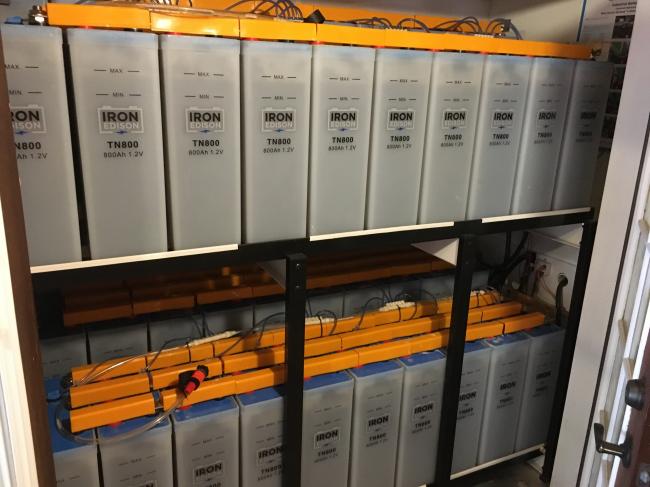
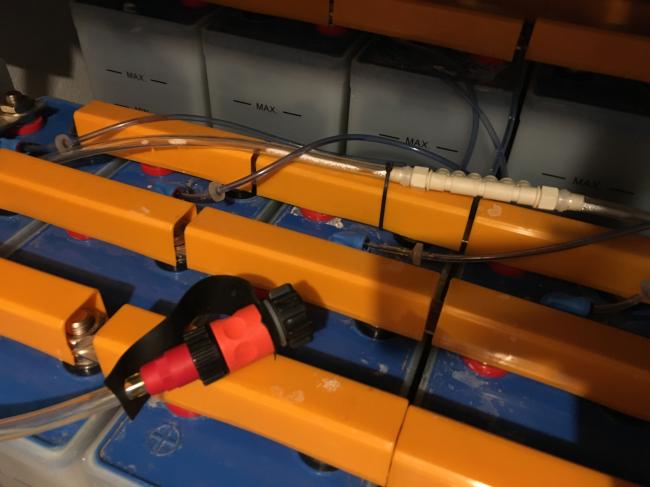
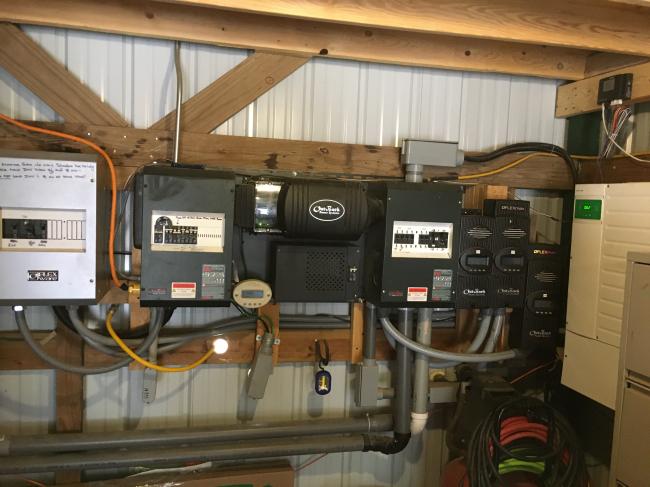
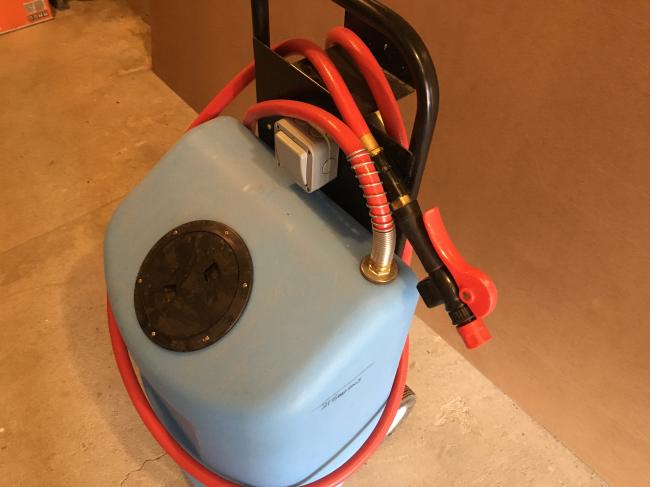
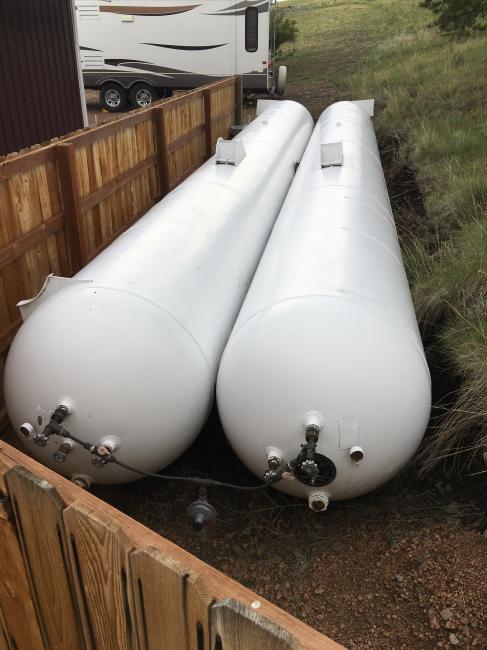
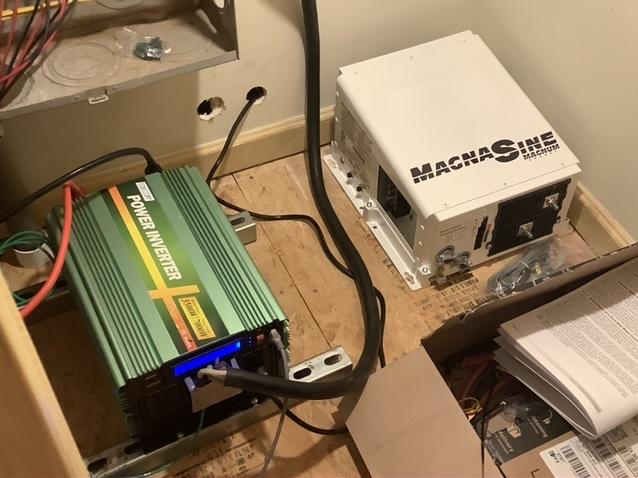 sweet! This picture is of the cheaper amazon inverter. The better one is the white one that’s not hooked to anything yet.
sweet! This picture is of the cheaper amazon inverter. The better one is the white one that’s not hooked to anything yet.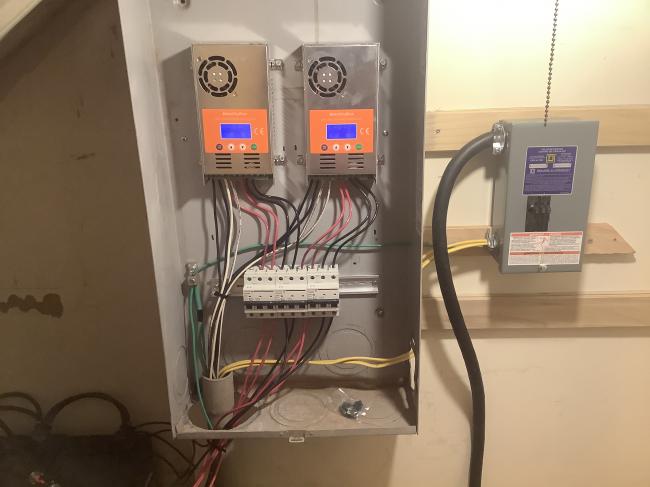 this is the dual charge controllers and the breakers between the battery bank. One thing to know is it’s really important that all the wires are the same length when using dual chargers. The resistance imbalance can mess with charging.
this is the dual charge controllers and the breakers between the battery bank. One thing to know is it’s really important that all the wires are the same length when using dual chargers. The resistance imbalance can mess with charging.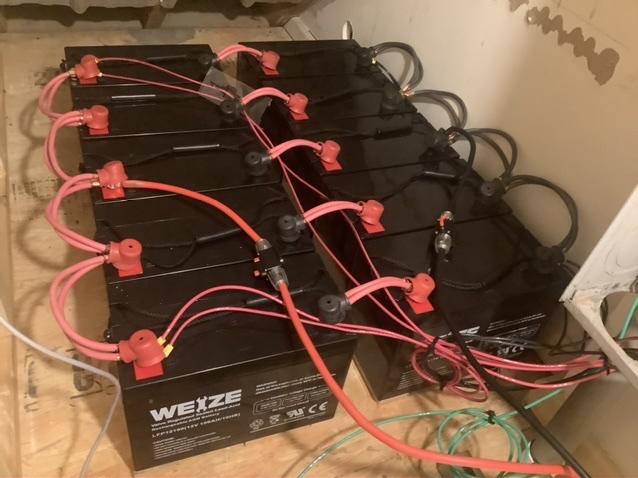 my first battery bank wired for 24v. Again all wires are identical lengths. I used parallel runs with the wiring here. Technically single wires were large enough but bigger is better when it comes to the battery bank.
my first battery bank wired for 24v. Again all wires are identical lengths. I used parallel runs with the wiring here. Technically single wires were large enough but bigger is better when it comes to the battery bank.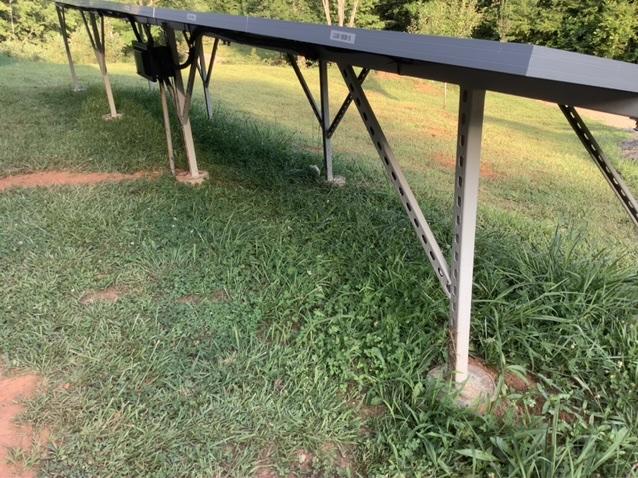 the welded rack system for the panels
the welded rack system for the panels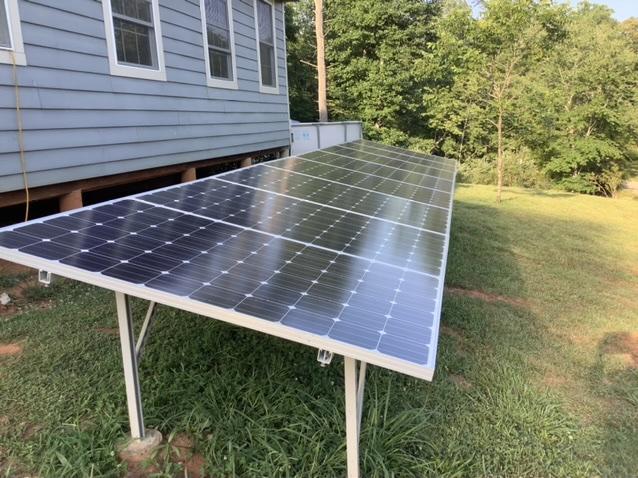 and the first row of panels. There is a combiner box under the panels that also has breakers between the panels and the chargers.
and the first row of panels. There is a combiner box under the panels that also has breakers between the panels and the chargers. 